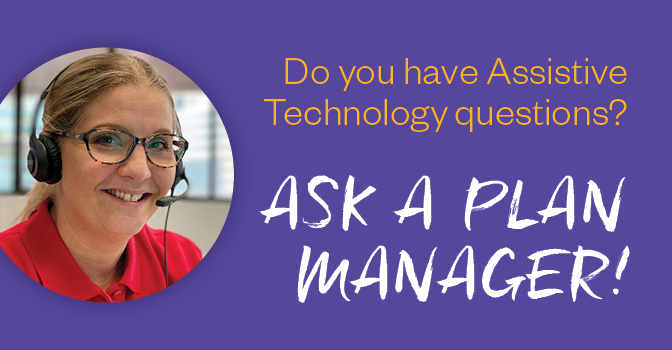Do you have assistive technology questions? Ask a plan manager!
Assistive technology is such a broad term that can include everything from adaptive cutlery to motorised wheelchairs and even home modifications. With different types, values and risk levels, it can be hard to get your head around AT.
Luckily, experienced Leap in! plan manager Tabitha can answer some of the most-frequently asked questions about AT, so that our children and young adults can benefit from the wide-ranging technology available.
Can you please explain how the new $15,000 limit for AT works?
Recent changes to the NDIS make it easier to purchase Assistive Technology (AT) with your NDIS funds, providing you meet the requirements.
The upper limit for automatic approval of Assistive Technology purchases has increased from $5,000 to $15,000.
Providing you have the relevant evidence, and the funding in your Plan budget, the NDIS will automatically approve funding for AT items up to $15,000. No quote is required. However, you will need to obtain a letter or report from an AT advisor outlining the item, how it will assist and why it is the best value for money.
My child is using some apps as part of their therapy sessions. Can I purchase a mobile phone or tablet with their NDIS funds?
The NDIS won’t usually pay for a tablet or mobile phone to run apps or assistive technology, even if an AT advisor or therapist supplies a letter of recommendation. These items are considered day-to-day living costs or general household appliances that the NDIS doesn’t fund in most cases.
The NDIS says it may only fund such a device if it is “solely and directly” related to the person’s disability needs. For example, if the device is the only way the child can communicate.
Apps related directly to your child’s support needs or goals can be purchased with NDIS funds. The NDIS won’t usually fund gift cards for iTunes or Google Play, so it is best to buy apps yourself and obtain reimbursement.
Can I use my child’s NDIS funding to trial assistive technology before buying?
With so many different brands and options for AT, you’ll sometimes want to test an item before buying or renting. Some providers will let you try a product at no cost.
If a longer trial is required, or the provider has to travel to adjust the item, you can use your child’s NDIS funds to pay for these costs.
The NDIS has developed a guide of the guide of the expected prices for common items trialled or rented with NDIS funds.
Does “higher risk” AT refer to items that cost more?
Good question! The NDIS has two “product” risk categories for assistive technology: low risk and higher risk.
While higher risk technology is often more expensive, this is not always the case. For example, bedsticks, transfer aids, postural supports, orthotics and many pressure care items may fall under the Low Cost AT category, but are still considered higher risk.
Higher risk items are generally more complex and often require personalised setup. For this reason, advice from an AT advisor or assessor is required before purchase. The NDIS will not fund some high risk items such as trampolines or swings.
My son’s school says I need to use his NDIS funds to pay for AT to support his learning at school. Is that right?
While the NDIS may fund some types of assistive technology that will help your child at school, the education system is responsible for providing at-school supports and ensuring your child can access the curriculum.
Schools are responsible for providing:
- Modified software/hardware required for classroom subjects
- Braille textbooks
- Building modifications (such as ramps to classrooms)
- Non-transportable equipment for your child that remains in the classroom
- Specialised school furniture
- Bathroom supports.
The NDIS funds AT that the student needs regardless of whether they are at school or not, such as hearing aids, wheelchairs or specialised communication devices.
What should I do with AT funded by the NDIS if it is no longer needed?
If you have purchased the equipment, you can take it to a service in the community that accepts and refurbishes used equipment or donate it to charity. If it is under a lease agreement, you will need to arrange to return it to the provider. Depending on the item, you may also be able to sell it privately.
My daughter needs several new items of low cost AT to help her achieve her goal of being more independent at home in her next NDIS Plan. How do I know how much to ask for?
The NDIS has a useful guide for low cost AT support funding. For example, allow around $50 each for everyday items such as adapted grip cutlery and non-slip bathmats, or $150 for elbow crutches.
If the items needed are not listed, make a note of how they will help your daughter achieve her goals, a brief description and an approximate cost to take to your next Plan meeting.
Keep in mind that any AT purchased by the NDIS must be value for money, and the NDIS will often explore lower cost options, if they’re available.
Do you have a question you’d like us to answer or a topic you would like us to dive into?
We’d love to hear from you. Send your question to mystory@leapin.com.au.
Leap in! can help you navigate the NDIS and get the most from your child’s plan. We also take care of all the time-consuming bookkeeping! Call us on 1300 05 78 78 to learn more about plan management.
Further reading
Assistive technology purchases up to $15,000 to be approved automatically.
Will the NDIS pay for repairs and maintenance to assistive technology?
Kids and the NDIS: Assistive technology in the learning environment.

